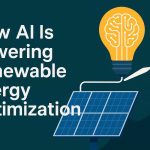As the global demand for cleaner and more sustainable energy solutions grows, the renewable energy sector faces one critical challenge—efficiency. Wind, solar, and hydro sources are abundant but often unpredictable. That’s where Artificial Intelligence (AI) steps in, transforming renewable energy systems into smarter, self-learning ecosystems.
From forecasting solar power generation to managing energy grids and reducing waste, AI is becoming the invisible engine behind the world’s transition to a net-zero future. Let’s explore how AI is driving renewable energy optimization and reshaping the future of global sustainability.
1. AI in Energy Forecasting: Predicting Nature’s Patterns
One of the biggest challenges in renewable energy is intermittency—the variability in energy production caused by weather changes. Solar panels only generate power during sunlight, and wind turbines rely on wind speeds. AI tackles this issue through predictive analytics and machine learning algorithms that process massive datasets from satellites, weather sensors, and past generation patterns.
For instance:
- AI-powered weather models predict sunlight intensity and wind speeds with over 90% accuracy.
- Deep learning models analyze historical patterns to forecast energy output hours or even days in advance.
This predictive capability allows operators to balance supply and demand more effectively, ensuring a consistent energy flow to the grid while minimizing storage losses.
Example: Google’s DeepMind uses AI to forecast wind power generation 36 hours in advance, improving the overall efficiency of its wind farms by nearly 20%.
2. Optimizing Energy Storage and Grid Management
Renewable energy doesn’t just need generation—it needs storage and distribution systems that can adapt in real time. AI enhances both.
AI in Energy Storage:
Battery management is vital to renewable energy success. AI systems monitor battery health, predict failures, and determine the best times to charge or discharge energy. By doing so, they extend battery life and reduce operational costs.
AI in Smart Grids:
Modern energy grids powered by AI—called smart grids—use sensors and machine learning to predict and respond to electricity demand dynamically.
- They automatically redirect energy to high-demand areas.
- Detect and isolate faults instantly.
- Balance renewable and non-renewable energy sources for stable power delivery.
AI-driven grid management ensures that renewable energy isn’t wasted when generation exceeds consumption, making the system more reliable and cost-effective.
3. Enhancing Wind and Solar Farm Efficiency
AI-powered drones, computer vision, and machine learning models are revolutionizing how renewable farms are monitored and maintained.
In Solar Energy:
- AI image recognition detects dust accumulation or panel defects using aerial or thermal imagery.
- Algorithms analyze production data to identify inefficiencies and recommend maintenance schedules automatically.
- Smart trackers, powered by AI, adjust panel angles throughout the day for maximum sunlight absorption.
In Wind Energy:
- Predictive maintenance models analyze vibration and sound data to detect early signs of turbine wear.
- AI optimizes turbine angles and rotation speeds to maximize output based on real-time wind patterns.
These intelligent systems can increase energy output by 10–15% and drastically reduce downtime.
4. Smart Demand Response: AI Meets Consumer Energy Behavior
Another major advantage of AI in renewable energy is demand-side management—aligning consumer energy use with renewable availability.
AI analyzes consumer data, such as appliance usage patterns, peak hours, and local energy supply, to automatically adjust power distribution. For example:
- During sunny hours, more solar energy can power homes or electric vehicles.
- When renewable energy dips, AI temporarily reduces consumption on non-essential devices.
This process, known as demand response, helps avoid grid overloads and reduces dependency on fossil-fuel-based backup systems. It also gives consumers the ability to save energy costs while contributing to sustainability.
5. AI in Energy Trading and Market Optimization
Renewable energy markets are becoming increasingly data-driven. AI algorithms analyze market trends, weather forecasts, and energy demand to make real-time trading decisions.
For example, AI can predict when energy prices will rise or fall and automatically sell surplus renewable energy at optimal times. This ensures maximum profitability for producers while maintaining grid stability.
AI-enabled energy trading is now an essential component of virtual power plants (VPPs)—networks of distributed energy resources managed through centralized AI platforms. VPPs make the renewable energy ecosystem more dynamic, decentralized, and efficient.
6. Case Studies: AI in Action
Google DeepMind and Wind Energy
Google’s DeepMind AI system predicts wind turbine output 36 hours ahead, allowing energy producers to commit energy to the grid with greater accuracy. This has increased the value of wind energy by about 20%.
Siemens Gamesa Renewable Energy
Siemens uses AI-driven predictive maintenance to monitor thousands of wind turbines globally. Their system reduces operational costs and extends equipment lifespan, helping achieve higher uptime and reliability.
IBM Watson in Solar Power
IBM’s Watson uses AI to forecast solar radiation and optimize energy scheduling, improving solar farm efficiency and lowering the need for backup energy sources.
7. Challenges and Ethical Considerations
While AI holds massive potential, integrating it into the renewable sector isn’t without challenges:
- Data dependency: AI needs vast, high-quality data for training, which can be expensive to gather and maintain.
- Cybersecurity risks: Connected grids and devices increase vulnerability to digital attacks.
- Energy consumption: Ironically, some AI models consume significant computational energy, which must be balanced against their environmental benefits.
Ethical use of AI in energy should ensure transparency, data privacy, and minimal carbon footprint during model training and operation.
8. The Future of AI in Renewable Energy
By 2030, AI is expected to become the core engine behind all major renewable systems. Emerging technologies such as edge AI, blockchain-based energy trading, and AI-driven climate modeling will bring even greater efficiency.
Future energy systems will likely be:
- Self-optimizing, using continuous learning models.
- Decentralized, managed by interconnected AI platforms.
- Autonomous, with minimal human intervention.
AI won’t just support renewable energy—it will redefine how we produce, store, and consume power.
Conclusion: AI and Renewable Energy—A Partnership for a Greener Planet
Artificial Intelligence is doing more than optimizing renewable energy; it’s accelerating the world’s transition to sustainability. From predictive maintenance and demand forecasting to smart grids and trading, AI ensures that every watt of renewable energy is used intelligently.
The synergy between AI and renewable energy is a glimpse of a smarter, cleaner, and more sustainable future—one where technology and nature work together to power the planet responsibly.





